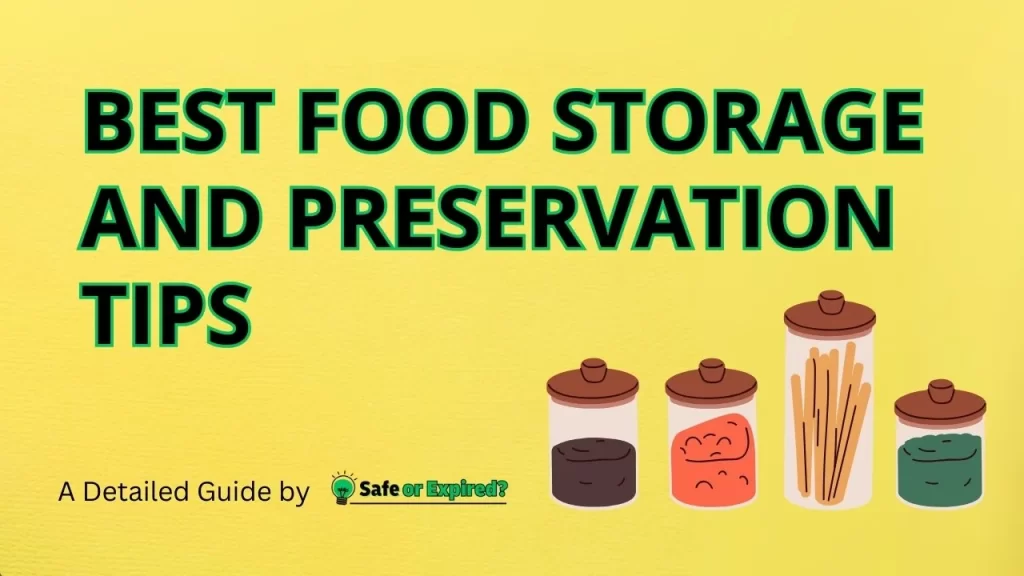Are you looking to keep your food fresh and flavorful for longer? This comprehensive guide on the best food storage and preservation tips offers practical strategies that can help you extend the shelf life of your groceries and maintain their nutritional value. The best part? All the tips are super easy to follow!
Let’s start.
10 Best Food Storage Tips To Extend Food Shelf Life
To ensure the best food storage, maintain your refrigerator below 40°F and your freezer at 0°F. Utilize airtight containers to shield food from moisture and unwanted odors. Regularly organize and inspect your storage areas to preserve food freshness and reduce waste, keeping your groceries safe and extending their shelf life.
Keep it Cool
Maintaining the right temperature for food storage. Note that improper temperature is one of the leading causes of bacterial attacks. The USDA recommends keeping your refrigerator at or below 40 degrees Fahrenheit. For the freezer, 0 degrees Fahrenheit is recommended. This can significantly hinder bacterial growth and ensure your food remains safe to eat.
Studies also show that keeping your refrigerator organized and not overcrowded can help maintain a more consistent and appropriate temperature. This promotes better air circulation and cooling efficiency, which are critical for food preservation.
Examples of Proper Refrigeration:
- Dairy products: Store milk, cheese, and yogurt in the coldest part of the refrigerator to keep them fresh longer.
- Meat: Store raw meat on the lowest shelf to prevent juices from dripping on the other items, potentially contaminating them.
Use Airtight Containers
Airtight containers are a staple in effective food storage. They work by creating a seal that minimizes the food’s exposure to air, thereby slowing down the oxidation process. Note that this can lead to spoilage and food waste.
Here’s a picture of airtight containers:
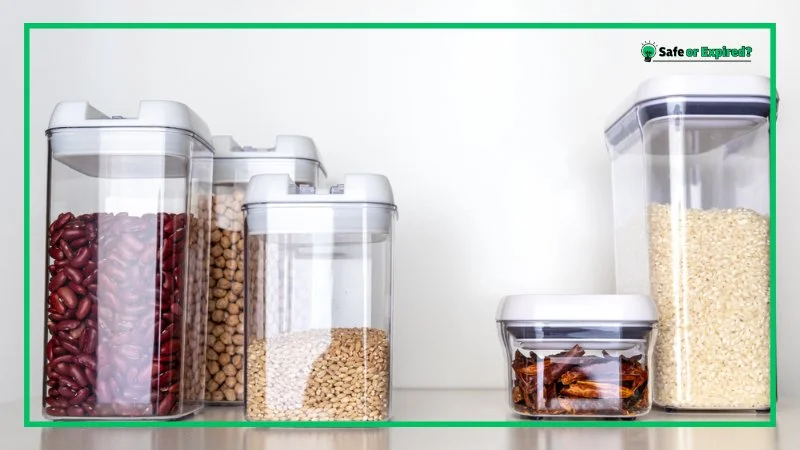
Here are the benefits of airtight storage:
- Freshness: Sealed containers keep food fresher longer by locking in moisture and flavor.
- Prevention of Contaminants: Airtight containers protect food from environmental contaminants and pests, such as insects and rodents.
- Versatility: They can be used in both the refrigerator and the pantry. They are suitable for a wide range of food items, from leftovers to dry ingredients like flour and sugar.
Opt for containers made from materials like glass or high-quality plastics that don’t release harmful chemicals. Containers that are dishwasher-safe and designed for multiple uses are ideal for both convenience and environmental sustainability.
Practical Tip: Label your containers with the date the food was stored. This simple step can help you track shelf life and ensure you use older items first, adhering to the “first in, first out” principle.
Check Food Temperatures
Keeping an eye on your fridge and freezer temperatures is key to food safety. The ideal fridge temperature is below 40 degrees Fahrenheit. If you have a freezer, then it should be at 0 degrees Fahrenheit. By sticking to these guidelines, you ensure that your food stays fresh and safe.
Why does it matter? Well, two reasons:
- Food Safety: Low temperatures slow down bacterial growth, keeping your food safe.
- Food Quality: Proper temperatures keep your food tasting better for longer.
But how to do it? Well, use a fridge thermometer to check the temperature regularly. This simple tool helps you avoid the guesswork and keep your food in the best condition.
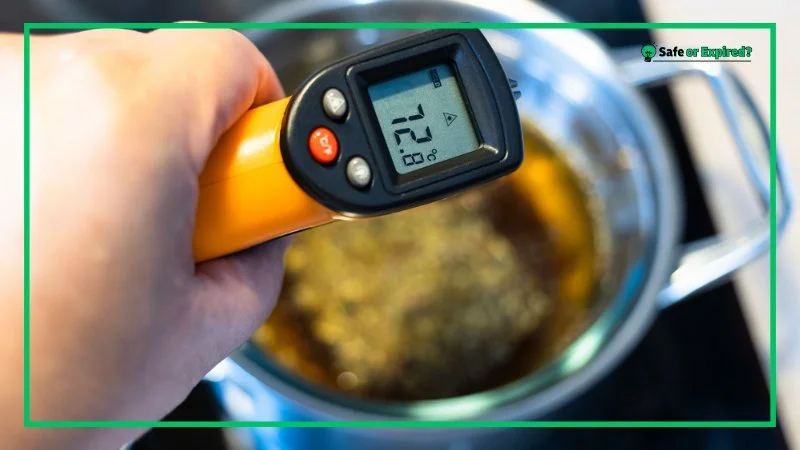
Label and Date
Labeling and dating your food items is a simple yet effective way to manage your kitchen. This practice helps you track when food was stored and makes it easier to use older items first, reducing waste.
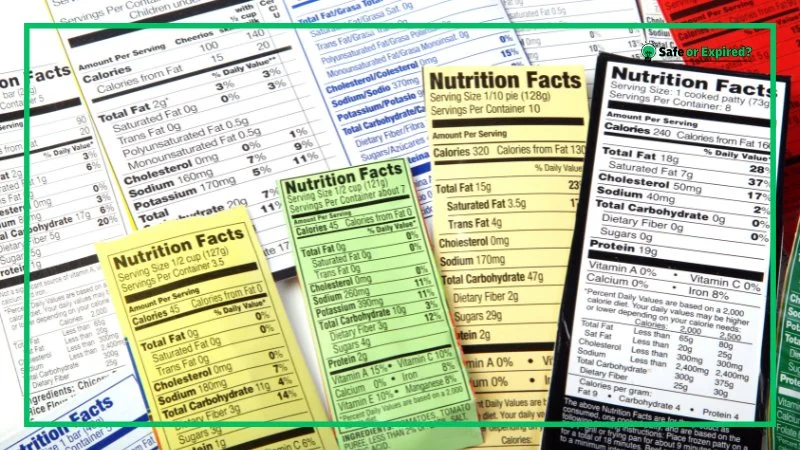
These are the benefits of Labeling.
- Avoid Waste: By using food before it spoils, you save money and reduce waste.
- Stay Organized: Labels help you find what you need quickly, keeping your fridge and pantry tidy.
Dry Storage
According to NCHFP, managing your dry storage effectively is crucial for extending the shelf life of pantry items such as grains, flour, and spices. These ingredients do best in cool, dark places where moisture and heat are minimized. The right dry storage practices prevent spoilage and infestations, keeping your staples fresh and ready to use.
Best Practices for Dry Storage:
- Location: Choose a pantry or cabinet that’s away from heat sources like stoves or dishwashers.
- Containers: Use airtight containers to keep pests out and maintain freshness. Clear containers help you see what you have at a glance.
- Organization: Arrange items so that older products are in front and used first, following the “first in, first out” principle.
Manage Ethylene Producers
Ethylene is a natural gas that some fruits and vegetables emit as they ripen. This gas can spoil food. It can accelerate the ripening and eventual spoilage of sensitive produce nearby. Managing ethylene producers in your kitchen can help extend the freshness of all your fruits and vegetables.
Ethylene Producers to Watch: Apples, Bananas, and Tomatoes: These are high ethylene producers. Keep them separate from ethylene-sensitive items like leafy greens and peppers to prevent premature spoilage.
These are the best tips for managing ethylene:
- Storage: Store high ethylene-producing items in a different part of the kitchen or in a separate fruit bowl.
- Ventilation: Ensure good airflow in your storage areas to disperse ethylene gas, reducing its impact.
Avoid Cross-Contamination
Cross-contamination is one of the primary concerns in food storage, where harmful bacteria are unintentionally transferred from one food item to another. According to the CDC, this can lead to foodborne illnesses, making it crucial to organize and store raw food properly to ensure safety.
So, follow basic food safety guidelines and never mix raw chicken and vegetables.
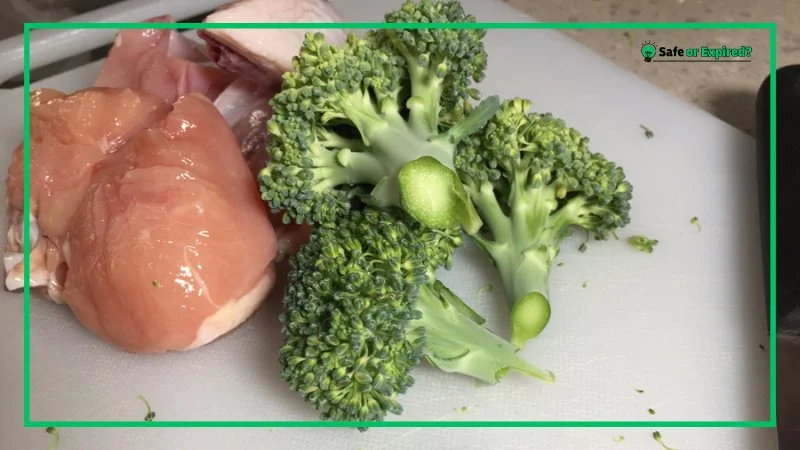
Strategies to Prevent Cross-Contamination:
- Separate Raw and Cooked Foods: You should always keep raw meats separate from cooked and ready-to-eat foods. Use separate cutting boards and utensils for these items.
- Store Foods Properly in the Fridge: Place raw meat in containers or sealed plastic bags on the bottom shelf. The meat juices won’t drip onto other foods.
- Wash Hands and Surfaces Often: Regularly clean your hands, cutting boards, countertops, and utensils with hot, soapy water before and after handling different food items.
Implementing these practices will drastically reduce the risk of foodborne illnesses in your kitchen and help maintain the overall health of anyone consuming the food.
Use Clear Containers
Using clear containers for food storage is not just about aesthetics. It offers several practical benefits that can enhance the safety of your kitchen.
Check out the picture of clear containers:
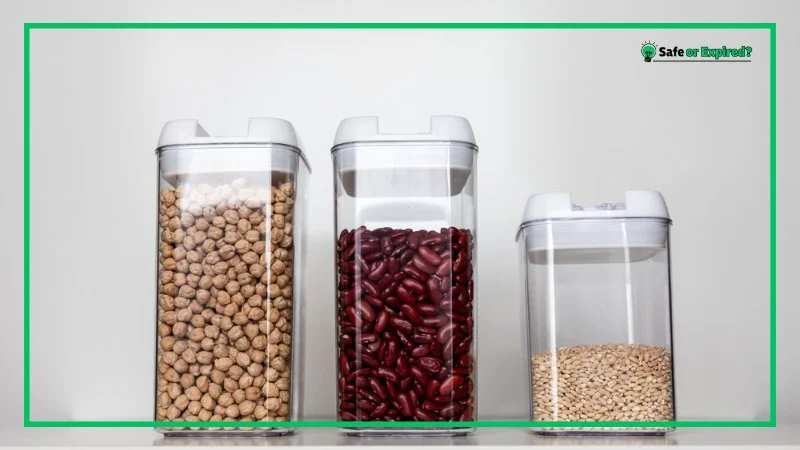
Here are the advantages of clear containers:
- Visibility: Clear containers allow you to see exactly what’s inside without needing to open the lid. This visibility makes it easier to keep track of your inventory and helps in identifying any spoilage or infestation early.
- Efficiency: With everything visible, you can quickly find what you need. This will save time during meal preparation.
- Consistency in Storage: Using uniformly sized clear containers can help in maximizing space, especially in smaller kitchens. They can be stacked and aligned neatly, making the best use of available storage areas.
These are the best tips for choosing the right containers:
- Material: Opt for high-quality, food-safe materials like BPA-free plastics or glass. These materials are resistant to chemical leaching and can endure multiple washing
- Seals: Choose containers with tight-fitting lids to keep air out and preserve the freshness of the contents longer.
- Labeling: Even with clear containers, labeling them with dates and contents can help track expiration dates and maintain an efficient kitchen rotation system.
Regularly Clean
According to USDA, maintaining a clean storage environment is vital for the health and safety of your food. Regular cleaning prevents bacteria and molds. It also keeps the space organized. This ensures that foods are stored in the best conditions possible.

The top two benefits of regular cleaning:
- Prevents Contamination: Frequent cleaning of your refrigerator, freezer, and pantry removes crumbs and spills that can attract pests.
- Extends Appliance Lifespan: Keeping your appliances clean can improve their efficiency and prolong their lifespan, saving you money on repairs and energy costs over time.
Here are the cleaning schedule tips:
- Daily: Wipe up any spills immediately to prevent stains and odors.
- Weekly: Check for expired items and wipe down interior surfaces of refrigerators and pantries.
- Monthly: Deep clean your storage areas by removing everything, cleaning all surfaces, and checking expiration dates before putting items back.
Use the FIFO method.
The First-In, First-Out (FIFO) method is a critical organizing principle for managing inventory, especially in food storage. This method ensures that older stock is used before newer stock, reducing waste and ensuring the freshness of the food you consume.
Implementing FIFO:
- Labeling: Clearly label each item with the date it was purchased or prepared. This makes it easier to identify which items should be used first.
- Organization: Organize shelves so that older items are at the front and newer items are at the back. This setup encourages the use of older items before reaching for the newer ones.
- Regular Checks: Regularly check your inventory to reorder and rotate items, ensuring the oldest stock is used first and noting what needs to be replenished.
These are the advantages of FIFO:
- Reduces Waste: By using older items first, you minimize the chance of having to throw away food due to spoilage.
- Maintains Quality: FIFO helps maintain the quality of food since items stored for too long can lose their flavor, texture, and nutritional value.
10 Best Food Preservation Tips To Keep Food Fresh
For effective food preservation, utilize methods like canning, drying, and freezing. Store dry goods in cool, dark places and use airtight containers for refrigerated items. Furthermore, pickling, oil packing, and root cellaring are other proven tips that can keep the food fresh.
Canning Tips
Canning involves processing food in closed containers to keep it safe and consumable for long periods. The method you choose—pressure canning or water bath canning—depends largely on the acidity of the foods you’re preserving.

You should do these two types of canning:
- Pressure Canning: Ideal for low-acid foods like vegetables, meats, and some fruits. This method uses a pressure canner to heat the contents to 240 degrees Fahrenheit, effectively killing harmful bacteria and creating a vacuum seal.
- Water Bath Canning: Best suited for high-acid foods such as fruits, pickles, and tomato-based sauces. The process involves boiling the jars in water at 212 degrees Fahrenheit, which is sufficient to preserve these types of foods safely.
Always use clean, sterilized jars and follow up-to-date safety guidelines. Doing this will prevent the risk of foodborne illnesses like botulism. Furthermore, ensure that seals are tight and jars are stored in a cool, dark place to maximize shelf life.
Drying Tips
Drying is another excellent method for preserving a wide range of foods. By removing moisture, you help stop the growth of bacteria, yeasts, and molds.
The two drying methods you should try are:
- Food Dehydrator: This appliance is specifically designed for drying foods evenly and efficiently, allowing you to set precise temperatures that are ideal for the type of food you’re drying.
- Oven Drying: If you don’t have a dehydrator, you can use an oven set to a low temperature. You should ensure that foods are sliced uniformly to promote even drying.
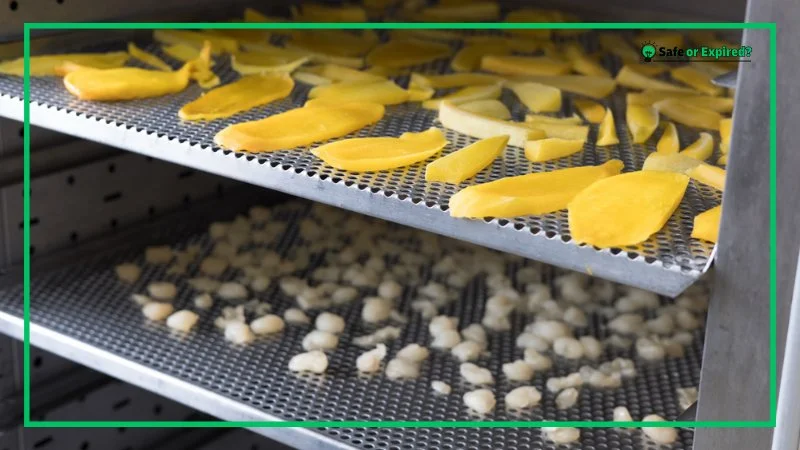
Pickling
According to the Encyclopedia of Food Sciences and Nutrition, Pickling is a fantastic way to extend the shelf life of various foods, from classic cucumbers to more adventurous options like fruits and eggs. The process involves immersing the foods in a mixture of vinegar, water, and salt, creating an acidic environment. This environment inhibits the growth of harmful bacteria.
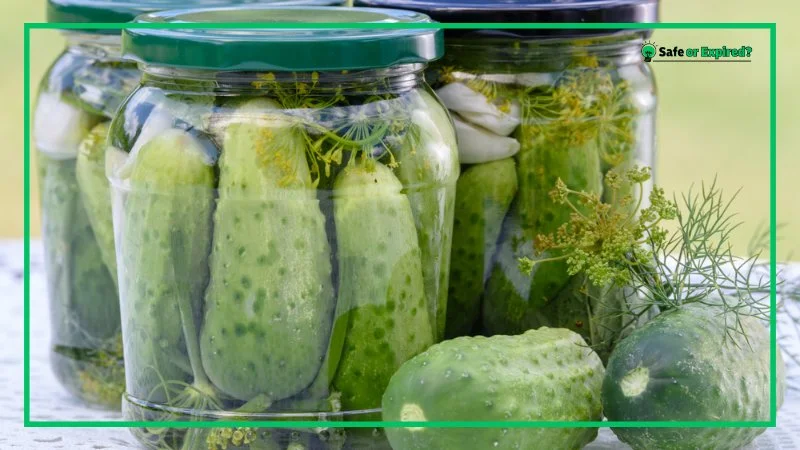
Follow these two tips for successful pickling:
- Make sure to use fresh fruits and vegetables that are free from bruises to ensure the best final quality.
- Keep the jars in a cool, dark place to maintain the pickles’ quality and longevity.
Fermenting
“Regulating the Safety of Traditional and Ethnic Foods” Book states that fermentation preserves food and enhances its nutritional value. Commonly fermented foods include sauerkraut, kimchi, and yogurt, each undergoing a natural process where microorganisms (like bacteria) break down food components into more digestible forms.
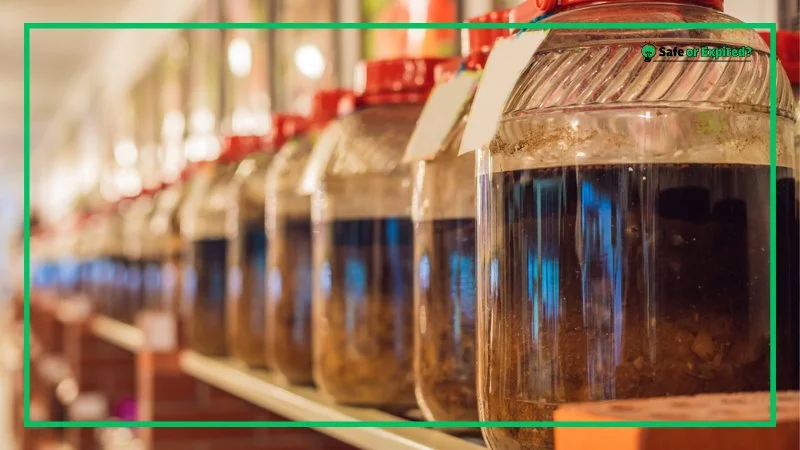
Follow these fermentation tips:
- Temperature Control: Most fermentation processes require a consistent, moderate temperature (around 70°F) to thrive.
- Time: Depending on the desired sourness and the specific bacteria involved, fermentation can take anywhere from a few days to several weeks.
- Hygiene: Always use clean, sanitized containers and utensils to avoid introducing undesirable microorganisms.
Salting
Salting is particularly effective for meats and fish. By drawing moisture out of the food, salt creates an environment that is inhospitable to bacterial growth, which is essential for prolonging the shelf life of perishable items.
These types of Salting are the easiest:
- Dry Salting: Directly apply salt to the food. This method is often used for meats like ham or for fish like cod.
- Brine Salting: Immersing food in a solution of salt and water. This technique is typically used for foods that benefit from a gentler curing process, like cheeses and olives.
Follow these two tips for successful salting:
- Use non-iodized salt to avoid any chemical tastes and ensure a purer flavor.
- Maintain the proper salt-to-food ratio to ensure effectiveness without overly salting the food.
Smoking
The “Food Processing Technology” book highlights that smoking is not only a method to preserve meat and fish but also a way to infuse food with unique, smoky flavors. The smoke acts as an antimicrobial and antioxidant coating that helps slow down the spoilage process.
The benefits of Smoking are:
- Flavor Enhancement: Smoke can impart a variety of flavors. It depends on the type of wood used, such as hickory, maple, or applewood.
- Extended Shelf Life: The antimicrobial properties of smoke help preserve the food longer than many other methods.
The two tips to follow are:
- Ensure proper ventilation. It allows the smoke to circulate around the food.
- Monitor temperature closely to achieve the desired preservation and flavor without overcooking the food.
Sugaring
Sugaring is a method of preservation that involves using sugar to prolong the shelf life of foods, especially fruits. By creating a high-sugar environment, water activity within the food is reduced, making it difficult for microorganisms to thrive. This method is commonly used to make preserves, jams, and jellies.
The two popular sugaring techniques are:
- Jams and Jellies: Fruit cooked with sugar until it reaches a gel-like consistency, often enhanced with pectin to aid gelling.
- Preserves and Compotes: Whole fruits or large pieces preserved in sugar, retaining more of their original texture compared to jams.
Tips for Successful Sugaring:
- Use the correct ratio of sugar to fruit to ensure proper preservation and flavor balance.
- Sterilize all containers and utensils to prevent contamination and extend the shelf life of sugared products.
Vacuum Sealing
Vacuum sealing is a modern preservation technique that involves removing air from a package and sealing it to create an airtight environment.
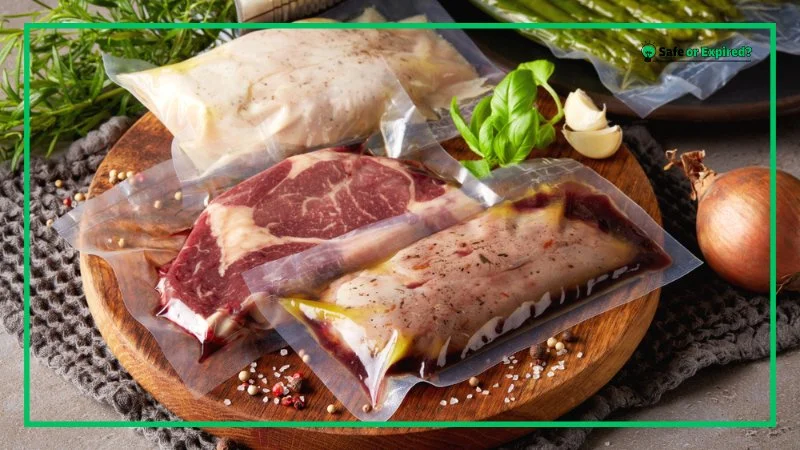
According to the Michigan State University, the Benefits of Vacuum Sealing are:
- Extended Shelf Life: By removing oxygen, vacuum sealing helps prevent the growth of aerobic bacteria and fungi.
- Protection Against Freezer Burn: In the freezer, vacuum sealing protects food from dehydration and oxidation due to cold air exposure.
- Space Efficiency: Vacuum-sealed packages are typically flatter and more compact, making it easier to organize and store more items in limited spaces.
These are the effective vacuum sealing practices:
- Proper Bag Selection: Use bags specifically designed for vacuum sealing to ensure they are durable enough to withstand punctures and provide a proper seal.
- Dry and Clean Edges: Ensure the edges of the bag are dry and clean before sealing to secure a tight and effective seal.
- Labeling: Always label vacuum-sealed items with the date and contents for efficient inventory management.
Root Cellaring
Root cellaring is an excellent method of storing perishables, particularly root vegetables like potatoes, carrots, and beets. This technique leverages the natural cool, humid, and dark conditions found in places like basements or underground cellars to keep these vegetables fresh through the colder months without the need for modern refrigeration.
These are the essentials of Root Cellaring:
- Cool Temperature: Ideal temperatures range from 32°F to 40°F, which slows down the metabolic processes of the vegetables, reducing spoilage.
- High Humidity: A humidity level of 80-90% is crucial to prevent the vegetables from drying out and shriveling.
- Darkness: Exposure to light can trigger sprouting and the production of solanine, particularly in potatoes, which is harmful if ingested in large quantities.
Setting Up a Root Cellar:
- Ventilation: Adequate air circulation is necessary to manage humidity levels and keep the air fresh.
- Insulation: Proper insulation ensures that the internal temperature remains stable despite external temperature changes.
- Organization: Vegetables should be sorted and stored in bins or on shelves to prevent bruising and to allow for easy access.
Oil Packing
Oil packing is a preservation method that involves submerging food, particularly dried or semi-dried items like tomatoes, garlic, and herbs, in oil. This technique effectively seals off oxygen, creating an anaerobic environment that inhibits the growth of aerobic bacteria and mold.
The best practices for oil packing are:
- Use Quality Oil: A good-quality olive or vegetable oil is recommended for its stability and flavor.
- Proper Preparation: Ensure that the food is well-dried or cured before submerging in oil to avoid water content, which can promote bacterial growth.
- Storage: Store oil-packed foods in the refrigerator to maintain quality and extend shelf life.
Be particularly cautious with garlic in oil, as it can be a risk for botulism if not handled or stored properly. It’s recommended to use acidified garlic or store the preparations in a refrigerator and consume them within a short period.
Conclusion
Mastering the best food storage and preservation tips is essential for maintaining the quality of your food and managing your kitchen efficiently. Here are some key takeaways to ensure your groceries remain fresh and safe:
- Temperature Management: Keep your refrigerator and freezer at optimal temperatures to inhibit bacterial growth and prolong food freshness.
- Effective Sealing: Use airtight containers and vacuum sealing to protect against contaminants and preserve food quality.
- Organization Strategies: Implement the FIFO (First In, First Out) method and regular cleaning schedules to maintain an organized and hygienic storage environment.
- Proper Preservation Methods: Utilize techniques like canning, drying, and pickling to keep food consumable for longer periods without losing taste or nutrients.
- Education on Food Safety: Stay informed about the latest food safety practices to ensure your food preservation methods are up-to-date and effective.
By incorporating these tips, you’ll be able to enjoy fresher ingredients, save money by reducing waste, and ensure your meals are delicious and nutritious.

